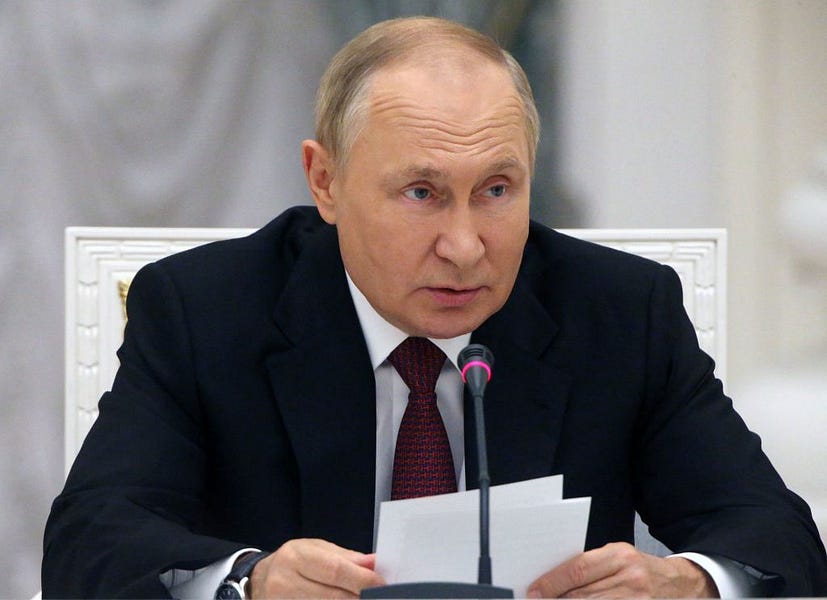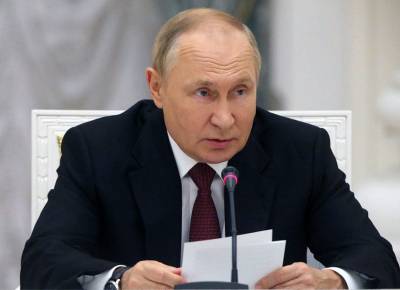The Russo-Ukrainian War has brought the world to its most dangerous moment since the Cuban Missile Crisis of 1962. No other single incident has had a higher potential to escalate into a general war between Russia and the United States, to inflict mass casualties on such a large number of people, or to bring such a high level of disruption to the global economy.
The Cuban Missile Crisis was the closest the world has ever come to nuclear war. When American U-2 spy planes discovered Soviet nuclear missiles on Cuban soil under the newly installed Communist regime of Fidel Castro, President John F. Kennedy publicly demanded their withdrawal and blockaded all shipments to and from Cuba. For two weeks Kennedy and his counterpart, Soviet General Secretary Nikita Khrushchev, played a game of chicken, each daring the other to take a step closer to war. Khrushchev blinked, withdrew the missiles (in exchange for the United States’ discreetly doing the same with its missiles in Turkey), and the crisis was defused.
The Cold War was frighteningly dangerous, but after the Cuban Missile Crisis both sides worked to improve communication. The protracted contest took on a strange stability, even amid the Vietnam and Afghan wars: The superpowers grew accustomed to each other’s moves and countermoves and knew what was within expected parameters (espionage, proxy wars, arms treaties) and what violated them (cross-border operations by Afghan mujahedin into Soviet territory, for example, or any direct combat between the superpowers within a proxy battlefield). The predictability made crises manageable. That is partly why nothing in the past 60 years has brought the world so close to the brink of nuclear catastrophe.
But Russian President Vladimir Putin is trying his best. After broadening his invasion of Ukraine in February—the war started in 2014 but was limited to only part of the country—Putin threatened to use nuclear weapons if outside powers intervened. He also put Russia’s nuclear forces on heightened alert.
Putin did not act on the threat then, but in the months since the Russians have lost more soldiers than in any other war since World War II, or soon will. The Soviet-Afghan war may have killed from 15,000 to 26,000 Soviets over 10 years of fighting, and no other conflict since 1945 comes close. American intelligence estimated in August that six months of fighting has already killed at least 15,000 Russian troops, if not far more, and wounded tens of thousands. That’s an entire Iraq War’s worth of caskets every month. No developed country has experienced this level of bloodletting in generations. Putin recently called up several hundred thousand reservists and stepped up conscription to reinforce his bleeding army.
The Russo-Ukrainian War is also the closest that the United States and Russia have come to direct combat since Cuba. Rumors persist that Americans and Soviets traded fire on a few occasions in Korea and Vietnam, but there was never large-scale or publicly acknowledged combat between the two sides. Americans and Russians studiously avoided each other on the world’s battlefields, even as their proxies and their weapons killed tens of thousands on either side, knowing that a direct confrontation could escalate into general war. America and Russia have fought each other only once, a century ago, when 13,000 Americans intervened in the Russian Civil War.
By contrast, today the United States and NATO allies are openly arming Ukraine and training Ukrainian soldiers. During the Soviet-Afghan war, we maintained the polite fiction that we were uninvolved. Today, the Biden administration and our European allies publicly brag that American weapons are killing Russian soldiers. And American diplomats spearheaded a global campaign to crater the Russian economy through unprecedented sanctions. American diplomacy is impoverishing the Russian economy and American weapons are sending home Russian body bags, and Putin knows it.
Some want the United States to go further. Over the summer, former National Security Adviser John Bolton advocated for the United States to impose a no-fly zone over Ukraine. That would involve American warplanes shooting down Russian jets—or, in other words, an act of war.
The deepening crisis on the battlefield and the open involvement of America and Europe mean that Putin will have a hard time finding an acceptable exit short of victory. He is victim to sunk costs: Having lost so many Russians, and lost so much personal and national prestige, he must vindicate their blood and Russian honor and his own legacy by trying to push on to victory. He has repeatedly told his people that this is a conflict not against Ukraine but against the United States and the West. Backing down would be an acknowledgment that the United States defeated Russia—without losing a single soldier. For Putin, losing a major war will cost him his legacy, his power, and likely his life. The war is not existential for Russia, but it is for Putin: He wins or dies.
That is why Putin again threatened the use of nuclear weapons in his speech in mid-September announcing a partial mobilization of the Russian reserves. “In the face of a threat to the territorial integrity of our country, to protect Russia and our people, we will certainly use all the means at our disposal,” Putin said, “I will emphasize this again: with all the means at our disposal.” That’s diplo-speak for “I will use nuclear weapons if I have to.” U.S. National Security Adviser Jake Sullivan warned of “catastrophic” consequences if Putin follows through on his threat.
It is unclear exactly how Putin might actually use nuclear weapons. Ukraine does not have massed armored formations that would be the target of tactical or battlefield nuclear weapons. The Ukrainians may have a few underground facilities that Putin might target with “bunker buster” bombs. Otherwise, the only other thing he could do is detonate a “city buster” weapon over a center of Ukrainian resistance, like Kharkiv. But there is little military value proportional to such wanton destruction—and even Putin probably does not want to go down in history as the man who broke the nuclear taboo and murdered 1.5 millioin people. Putin claims he wants to save Ukraine from “neo-fascists,” not obliterate the country.
But that may be giving Putin too much credit. He has clearly and repeatedly threatened to use nuclear weapons. When dictators and aggressors tell us what they plan to do, we should believe them. Even if using a nuclear weapon appears irrational to us, it may look different to him. Our sense of what is rational is rooted in assumptions about the value of human life, the judgments of history, and the importance of public support—assumptions that, to Putin, may look deeply irrational.
It is impossible to know what will happen next week, let alone next month or next year. But if I were in charge of the Doomsday Clock, I would advance it a half-minute closer to midnight. The clock, invented by the Bulletin of the Atomic Scientists in 1947, is a dramatization of how close the world is to nuclear catastrophe. At the end of the Cold War, the clock was set to 17 minutes to midnight, the furthest setting in history, indicating the era of peace thought to be then unfolding. In 2020, it was set to 100 seconds (because of concerns over not just nuclear proliferation but climate change and cyber warfare) and has not yet been updated since the war in Ukraine began. Despite being the closest to midnight it has ever been, the clock may still be overestimating the stability of the present moment.






Please note that we at The Dispatch hold ourselves, our work, and our commenters to a higher standard than other places on the internet. We welcome comments that foster genuine debate or discussion—including comments critical of us or our work—but responses that include ad hominem attacks on fellow Dispatch members or are intended to stoke fear and anger may be moderated.
With your membership, you only have the ability to comment on The Morning Dispatch articles. Consider upgrading to join the conversation everywhere.